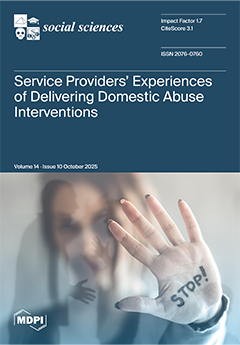Open AccessArticle
Chatbots and Empowerment in Gender-Based Violence: Mixed Methods Analysis of Psychological and Legal Assistance
by
Miluska Odely Rodriguez Saavedra, Erick Alexander Donayre Prado, Adolfo Erick Donayre Sarolli, Paola Gabriela Lujan Tito, Jose Antonio Escobedo Pajuelo, Ricardo Enrique Grundy Lopez, Orlando Aroquipa Apaza, María Elena Alegre Chalco, Wilian Quispe Nina, Raúl Andrés Pozo González, Manuel Edmundo Hillpa Zuñiga and Ruben Washington Arguedas Catasi
Cited by 1 | Viewed by 870
Abstract
The research explores how artificial intelligence-based chatbots transform psychological and legal assistance in situations of gender-based violence, evaluating their effect on women’s digital empowerment. A cross-sectional design with a mixed approach was used, combining a 25-item survey of 1000 women and a quantitative
[...] Read more.
The research explores how artificial intelligence-based chatbots transform psychological and legal assistance in situations of gender-based violence, evaluating their effect on women’s digital empowerment. A cross-sectional design with a mixed approach was used, combining a 25-item survey of 1000 women and a quantitative analysis using multiple correspondences and clustering techniques, supplemented by semi-structured interviews. The findings show that 64% considered the use of chatbots useful for accessing information, although only 27% used them to report incidents due to structural and digital barriers. Participants from rural areas faced severe connectivity limitations and expressed distrust of artificial intelligence, while those who interacted frequently demonstrated greater autonomy, decision-making capacity, and confidence in seeking support. Qualitative analysis showed that users valued confidentiality and anonymity as essential elements for sharing experiences of violence that they did not reveal in face-to-face settings. They also highlighted that immediate interaction with chatbots created a perception of constant support, reducing isolation and motivating users to seek formal help. The conclusion is that designing gender-focused chatbots and integrating them into care systems is an innovative and effective way to expand access to justice and psychological care.
Full article
►▼
Show Figures





